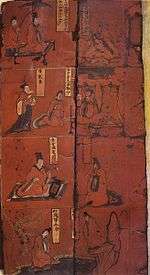Lacquer painting
Lacquer painting is a form of painting with lacquer which was practised in China and Japan for decoration on lacquerware, and found its way to Europe both via Persia and by direct contact with Asia. The genre was revived and developed as a distinct genre of fine art painting by Vietnamese artists in the 1930s; the genre is known in Vietnamese as "sơn mài."[1]

Technique
Making a lacquer painting may take several months depending on the technique used and the number of layers of lacquer. In Vietnam's sơn mài lacquer painting first a black board is prepared. Then outlines in chalk are picked out in white with eggshell and clear varnish, then polished. Then the first layer of coloured lacquer is applied, usually followed by silver leaf and another layer of clear lacquer. Then several more layers of different coloured lacquers are painted by brush, with clear lacquer layers between them. In Vietnam an artist may apply up to ten layers or more of coloured and clear lacquer. In Ming China processes included up to a hundred layers. Each layer requires drying and polishing. When all layers are applied the artist polishes different parts of the painting until the preferred colours show. Fine sandpaper and a mix of charcoal powder and human hair is used to carefully reach the correct layer of each specific colour.[2] Consequently, "lacquer painting" is in part a misnomer, since the bringing out of the colours is not done in the preparatory painting but in the burnishing of the lacquer layers to reveal the desired image beneath.[3]
National styles
China

Lacquer had been used since the Shang dynasty (1384-1111 BCE) for decoration and preservation of wooden objects. By the Han dynasty decoration had become more intricate.[4] Lacquer painting is sometimes used for decoration of wooden objects such as the traditional "Chinese candy box" or Chinese lacquerware tables.
Japan
In Japan lacquer painting is secondary to techniques such as silver inlay, Maki-e on Japanese lacquerware, and carving on Kamakura-bori, and Ryukyuan lacquerware. Painting did not feature on the "Japanning" works of industrial Britain.
Vietnam
Lacquer painting, known as sơn mài, from resin of the sơn tree, rhus succedanea, was developed in Vietnam as a freestanding form, separate from decoration of wooden objects. A revival and a combination with French techniques occurred in the 1930s which was closely associated with the French teachers and Vietnamese students of the École Supérieure des Beaux Arts de l’Indochine in Hanoi from 1925 to 1945 such as Joseph Inguimberty and Nguyễn Gia Trí.[5][6] Among the prominent newer generation of Vietnamese lacquer painters is Cong Quoc Ha, who received numerous awards and his works are regularly exhibited worldwide.
Russia
Russia's tradition of lacquer painting (Russian: лаковая живопись, lakovaya zhivopis) before the revolution was connected with folk art and production of icons. The Fedoskino miniature (Russian: федоскинская миниатюра) of Fedoskino village is a genre of lacquer miniature painting on papier-mâché, originating from the late 18th century. From the 1930s this genre also began to be used in proletarian art.[7] Russian lacquer painting is built up through several layers of varnish, creating a three-dimensional effect.[8]
References
- ↑ Flora Blanchon La question de l'art en Asie orientale; 2008. P. 2032: "Prior to this, lacquer painting was used by the Chinese and the Japanese, then, later, by the Vietnamese but, at that time, only for decorative purposes. After the 1930s, Vietnamese artists tried to go further and to develop the potential of this "
- ↑ The Process of Making Lacquer Paintings in Vietnam
- ↑ Arts of Asia Volume 32 2002 "The term lacquer painting is also misleading. Although the artist applies the lacquer paint with a brush, the essence of a lacquer painting depends upon the artist's skill in rubbing or burnishing the lacquer to reveal the image beneath."
- ↑ Kathleen Kuiper The Culture of China Page 232 2010 "Among the most celebrated examples of Han lacquer painting is a basket found at Lelang (National Museum, Seoul), decorated with 94 small figures of paragons of filial piety, virtuous and wicked rulers, and ancient worthies."
- ↑ Joyce Fan, Post đổi mới: Vietnamese art after 1990 : 12 May 2008 to 28 Sept 2008 Singapore Art Museum 2008 "The technique used in Vietnamese lacquer painting is complex and as the pumice stone is used in the polishing, it has ... The resin used is from the rhus succedanea or son tree and hence lacquer painting is known as son mai It is a highly ..."
- ↑ Thavibu Gallery for Modern Asian Contemporary Arts Paintings "The first lacquer paintings were quite traditional in expressing scenes of natural beauty. Later, lacquer paintings promoted socialist and communist values. However, since Vietnam became more outward looking in the 1980s and 1990s, young .."
- ↑ Soviet literature: Issues 1-4 1974 "... papier-mache art of Mstyora as well as the work of such villages as Fedoskino, Palekh, Kholui and Zhostovo belongs to the group of traditional crafts known collectively as "Russian laquer work. ... From the 18th century onwards it was famous for its icon-painting and restoration work. ... In 1930 the artists who formed an independent artel "Proletarian Art" began to master the technique of laquer painting."
- ↑ Marianne Webb Lacquer: technology and conservation : a comprehensive guide 2000 Page 138 "12.4.2 Russian painting Russian lacquer painting is singled out for its unique approach to the art. which still continues today. The decorative painting is not carried out in a single layer. as found on many other European pieces. but built up through the layers. Each layer of varnish depicts part of the image. This method creates a three-dimensionality that is not found elsewhere. The picture actually floats in the varnish."
| Wikimedia Commons has media related to Lacquer painting. |
Further reading
- East Asian lacquer : the Florence and Herbert Irving collection. New York: The Metropolitan Museum of Art. 1991.